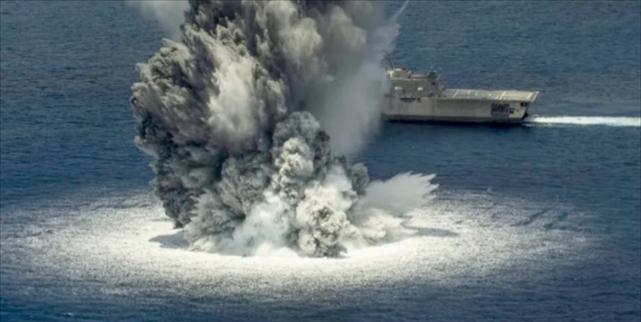Depth charges are too tough! 1 can sink a submarine, and the shock wave of thousands of meters is almost impossible to dodge
Veritable submarine "nemesis", in the First World War period was widely used in anti-submarine warfare, to World War II, half of the sunk submarines have to "credit" to the depth charges, and now after more than 100 years of development and change, this weapon is still in service with the naval forces of many countries, and today's performance is more powerful, 1 can sink submarines, the explosion radius is as high as thousands of meters, the shock wave generated is almost impossible to dodge.
A depth charge, also known as a depth bomb, is an anti-submarine weapon that looks like a barrel and is equipped with a fixed depth fuze, after the depth bomb is put into a predetermined depth, the internal fuze will be detonated, thus generating a huge shock wave to attack the target submarine. However, compared with today's various weapons and equipment with positioning avionics systems, depth charges are not equipped with any electronic equipment to detect nearby targets, so as to detonate at the best time, which is completely dependent on the depth of the fuze to set, that is, only experienced veterans know how to play the best effect of depth charges, if inexperienced recruits use, it may only be wasted.
The earliest origin of the depth charge was in the First World War, due to the strict sea blockade of the Allies by the Allies, Germany was blockaded and could not receive external material rescue, in order to break through the current predicament, it began to vigorously develop submarine forces, especially in 1917, Germany launched an "unrestricted submarine warfare" in one fell swoop, for a time German U-boats traveled in a high profile at sea, wantonly ran rampant in major seas, and released harsh words, "Whether it is military ships or non-military ships will be ruthlessly hunted", Therefore, in order to suppress the arrogance of the German army, depth charges were widely used, and the main target was underwater submarines.
The high explosives of the depth charge can produce a shock wave with a speed of about 8 kilometers per second, and compress the sea water in an instant, if the target submarine appears or is close to the position of the center point of the explosion, it will be hit by the shock wave, causing the ship's shell to be shattered, and if it is serious, the submarine will instantly become scrap iron. If the distance is far, the submarine will also suffer multiple shocks, because the explosion expansion will produce a shock wave, after the explosion of the water wave will instantly jump out of the water, and then return to the original position, in this process, will also produce a reverse impact, then the submarine needs to withstand this impact back and forth many times, until the pressure completely disappeared, according to the data, in the British test depth bomb impact test, the submarine in the water recorded up to 16 shock wave attacks.
Although in a certain sense, the deeper the depth of the submarine, the smaller the chance of being hit, but the deeper the diving position, the greater the pressure on the seabed, if hit by a depth bomb, the officers and men on the submarine will no longer have the possibility of survival, so, in general, for a thousand-ton submarine, as long as it is within 5-7 meters of the explosion range of the 100 kg TNT depth charge, it will be sunk.
By the time of World War II, when navies were fighting at sea, depth charges also became the main target of attack, and the United States and the Soviet Union, which were close to a crazy state of arms race at that time, also developed deep-sea nuclear bombs. By detonating a nuclear bomb in the water, the radius of destruction is enough to reach hundreds or even thousands of meters, far greater than the conventional loading of explosives, which is a tactical nuclear weapon with great lethality, and some countries at that time not only used it on ships, but also used aircraft to launch underwater attacks. However, with the technological advancement of modern torpedoes, nuclear depth charges have gradually faded from people's sight.
